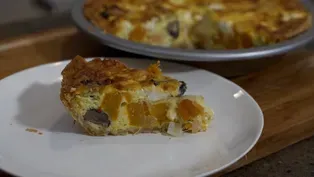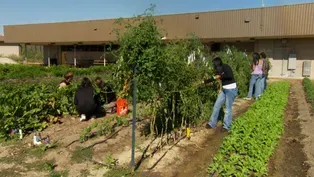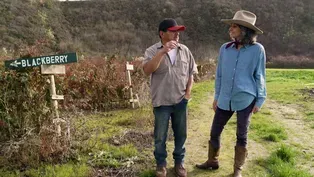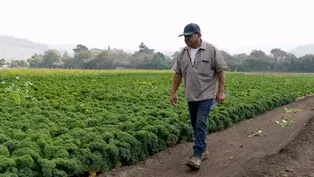
Tanaka Farms
Clip: 8/9/2024 | 5m 50sVideo has Closed Captions
Visit a pumpkin patch that attracts tens of thousands of people a year.
Meet the fourth-generation farmers behind this pumpkin patch in Southern California. It attracts more than 120,000 people a year who come to pick pumpkins - and much more!
Problems with Closed Captions? Closed Captioning Feedback
Problems with Closed Captions? Closed Captioning Feedback
America's Heartland is presented by your local public television station.
Funding for America’s Heartland is provided by US Soy, Sustainable Agriculture Research and Education, Rural Development Partners, and a Specialty Crop Grant from the California Department of Food and Agriculture.

Tanaka Farms
Clip: 8/9/2024 | 5m 50sVideo has Closed Captions
Meet the fourth-generation farmers behind this pumpkin patch in Southern California. It attracts more than 120,000 people a year who come to pick pumpkins - and much more!
Problems with Closed Captions? Closed Captioning Feedback
How to Watch America's Heartland
America's Heartland is available to stream on pbs.org and the free PBS App, available on iPhone, Apple TV, Android TV, Android smartphones, Amazon Fire TV, Amazon Fire Tablet, Roku, Samsung Smart TV, and Vizio.
Providing Support for PBS.org
Learn Moreabout PBS online sponsorship♪♪♪♪♪ Narr: Stand in the pumpkin patch at Tanaka Farms and nearby Interstate 405 and all the housing developments surrounding you somehow feel a world away.
Kenny: There used to be all farmland throughout Orange County here, but now there's not too many farms left.
Narr: Kenny Tanaka and his parents, Glen and Shirley farm at three locations in the heart of upscale Irvine in Southern California.
Kenny: So on this location, we have 30 acres.
We have pumpkins, squash, green beans.
Throughout the year, we'll go broccoli, carrots, radishes, a little bit of everything.
But behind us, we have about 20 acres of pumpkins that we're growing right now.
October is our biggest time of the year.
We sell a lot of pumpkins and invite people on the farm to pick their own pumpkins.
Our other big crop is strawberries.
Pretty much springtime for us.
Narr: These are not the first farmers in the Tanaka family.
Takeo worked as a farmhand when he arrived in the U.S. from Japan in the early 1900s.
The second generation Nisei in Japanese was George, who farmed until the start of World War Two when executive order 9066 put an end to a lot of California farms.
That executive order displaced 120,000 Japanese Americans who were forced to leave their homes and live in incarceration centers until the war ended.
But the Tanaka's left California before that happened.
Glenn: They said all Japanese off the West Coast.
They were fortunate, they had some friends in Utah, and so they were able to pack what they had and go to Utah.
That's where he met my mother.
My mother had already been living in Utah.
Narr: Glenn's parents married in Utah after the war.
The family returned to California, found land and started all over again.
Glenn: It was funny.
I was never told I was going to take over the farm.
It was just kind of understood.
Narr: But the business of farming had changed.
Over the years, Glenn made adjustments by adding a produce stand and gift shop and by offering community supported agriculture or CSA memberships.
And he still finds creative ways to market his crops.
Kenny: He's really good about pivoting.
During COVID, we really had to pivot and we did a drive through produce stand drive thru pumpkin patch.
Glenn: And that really touched the lives.
I still get people coming up to me now and say, You did a great thing for the community.
Narr: The farms successful expansion into agritourism started when Kenny was little.
Kenny: My mom brought our preschool class out to the farm.
And for the pumpkin patch, she showed us how seeds were grown and then showed us some of the vegetables when they were grown, let us pick a few and then take home a pumpkin.
Narr: Now more than 60,000 school kids visit Tanaka Farms every year on field trips.
Families visit, too, with as many as 120,000 people in a year for weekend events.
In just about any season, visitors can get their hands dirty and find out what vegetables look like before they reach the grocery store.
Kenny: Ive seen joy when they pick vegetables out of the ground because most of them never seen something like that.
So it's a really good experience.
Narr: Tradition is important to the Tanaka family and to their visitors.
Kenny: We get some adults that have come as children.
Now they're bringing their kids.
So that really makes us happy to see.
Narr: Visitors also learn about the Japanese-American farmers who lost their land during World War Two.
Glenn: We have a wall down there called the Issei, Nisei Farmers and their legacy.
That's the first and second generation Japanese-Americans that were over here.
There's probably over 7000 farms by Japanese-Americans, and of those, there is probably 6000 on the West Coast.
And every ethnic group has their history and story.
But this is really one that we think doesn't -- can't be lost because it talks about the, you know, the illegal incarceration of American citizens.
Narr: The Tanaka's are in their fourth generation, in part because they love farming in part to honor the history of Japanese-American farmers and in part to cultivate community.
Glenn: And with that community involvement, we've... we've probably helped our own business along the line but that really wasn't the intent.
It was getting involved with the community, being a part of the community and helping them out, because that's something businesses need to do.
I can't give you a good reason why.
It's just that's what we're supposed to do.
Narr: Agritourism is growing in popularity across the U.S., whether it's a pumpkin patch, a corn maze, an apple farm, or u-pick berries.
These farms introduce families to agriculture while preserving farmland and open space.
Revenue from agritourism tripled from 2000 to 2017, according to the USDA.
That's expected to grow as more people seek out these authentic farm experiences, often with picture perfect backdrops.
Autumn Vegetable Quiche – Farm to Fork with Sharon Profis
Video has Closed Captions
Clip: 8/9/2024 | 5m 41s | Find out how to cook an autumn vegetable quiche with mushrooms and leeks. (5m 41s)
Connecting and Feeding the Community
Video has Closed Captions
Clip: 8/9/2024 | 3m 20s | Discover how an urban school in the middle of a food desert built its own farm. (3m 20s)
Growing Perennials – Harvesting Health
Video has Closed Captions
Clip: 8/9/2024 | 4m 6s | Explore the nutritional benefits of berries with our health expert. (4m 6s)
Video has Closed Captions
Clip: 8/9/2024 | 4m 18s | A former farm laborer starts his own farm selling berries and rosemary. (4m 18s)
Providing Support for PBS.org
Learn Moreabout PBS online sponsorshipSupport for PBS provided by:
America's Heartland is presented by your local public television station.
Funding for America’s Heartland is provided by US Soy, Sustainable Agriculture Research and Education, Rural Development Partners, and a Specialty Crop Grant from the California Department of Food and Agriculture.















